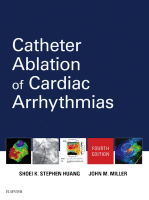Physical Address
304 North Cardinal St.
Dorchester Center, MA 02124

Key Points Isolated catheter ablation of persistent and long-standing persistent atrial fibrillation demonstrates marginal long-term outcomes. Technological improvements and minimally invasive techniques enable surgical ablation without sternotomy or cardiopulmonary bypass, but outcomes fall short of the cut-and-sew maze procedure. The…

Key Points Ablation of persistent and long-standing persistent atrial fibrillation (AF) is a potentially complex procedure, which carries a lower success rate than ablation for paroxysmal AF. Pulmonary vein isolation remains the cornerstone of AF ablation in every AF population…

Key Points Mapping Localized atrial fibrillation (AF) drivers commonly exist in spatially defined regions that may fluctuate over time but in the similar defined region. Similar AF drivers have been mapped in optical maps of human AF and by other…

Key Points Atrial substrate modification is required for a successful outcome in a minority of patients with paroxysmal atrial fibrillation (AF) and in most patients with persistent AF. Substrate modification is considered when AF persists despite effective elimination of pulmonary…

Key Points Nonpulmonary vein (non-PV) “triggers” can be identified in 10% to 33% of unselected patients with atrial fibrillation (AF). Compared with paroxysmal AF, the incidence of non-PV foci is higher in patients with persistent AF. Ablation of non-PV triggers…

Key Points Mapping Pulmonary vein antral positioning of the cryoballoon with proximal-seal method Pulmonary vein potential recording for time-to-isolation with Achieve Mapping Catheter Postablation voltage map (optional) Ablation Targets Pulmonary vein antral modification and pulmonary vein isolation Special Equipment Cryoballoon…

Key Points Pulmonary vein isolation (PVI) is the cornerstone of current ablation techniques for the treatment of atrial fibrillation (AF). Confirmation of electrical isolation with a circular mapping catheter is crucial to improve the short- and long-term outcomes of this…

Key Points Intraatrial reentrant tachycardia (IART) is a prevalent long-term consequence of congenital heart disease. IART may manifest as typical atrial flutter, atypical macroreentrant atrial tachycardia, or atrial fibrillation. In addition to causing symptoms, IART appears to be associated with…

Key Points Atypical or nonisthmus-dependent atrial flutter and atrial macroreentry requires fixed or functional barriers and regions of slow conduction. Atypical flutters are often recognized after catheter ablation or surgical treatment of atrial fibrillation (AF) or after surgery that involves…

Key Points The mechanism of most cavotricuspid isthmus (CTI)-dependent atrial flutter (AFL) is macroreentry around the tricuspid valve annulus (TVA). The diagnosis of CTI-dependent atrial flutter is made by demonstration of macroreentry around the TVA during entrainment at two or…